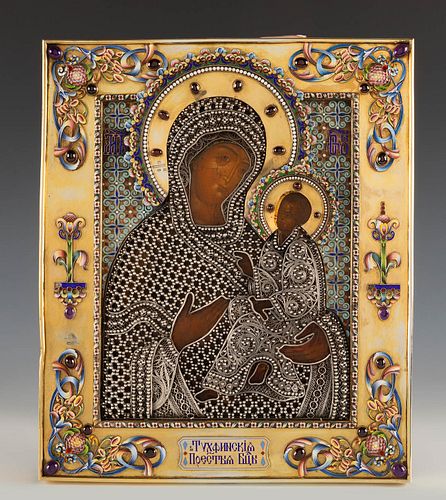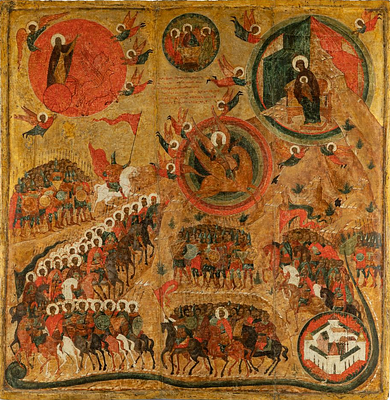Russian school, ca. 1900. "Mother of the God Tikhvinskaya". Tempera and gold leaf on panel. Oklad in gilt silver and cloisonné enamel, with filigree a
Lot 61
About Seller
Setdart Auction House
Carrer Aragó 346
Barcelona
Spain
Setdart Subastas was born in 2004 and is currently the first online art auction in Spain with solidity, prestige and reliability guaranteed by our more than 60,000 users. Setdart has a young, dynamic and enterprising team ready to successfully manage the purchase and sale of art works through custom...Read more
Estimate:
EUR€8,000 - EUR€9,000
$8,333.33 - $9,375
Absentee vs Live bid
Two ways to bid:
- Leave a max absentee bid and the platform will bid on your behalf up to your maximum bid during the live auction.
- Bid live during the auction and your bids will be submitted real-time to the auctioneer.
Bid Increments
| Price | Bid Increment |
|---|---|
| EUR€0 | EUR€10 |
| EUR€200 | EUR€25 |
| EUR€500 | EUR€50 |
| EUR€1,000 | EUR€100 |
| EUR€3,000 | EUR€200 |
| EUR€5,000 | EUR€500 |
| EUR€10,000 | EUR€1,000 |
| EUR€20,000 | EUR€2,000 |
| EUR€50,000 | EUR€5,000 |
About Auction
By Setdart Auction House
Sep 23, 2021
Set Reminder
2021-09-23 10:00:00
2021-09-23 10:00:00
America/New_York
Bidsquare
Bidsquare : RUSSIAN ICONS
https://www.bidsquare.com/auctions/setdart-auction-house/russian-icons-7431
Setdart Auction House sofia@setdart.com
Setdart Auction House sofia@setdart.com
- Lot Description
Russian school, ca. 1900. "Mother of the God Tikhvinskaya". Tempera and gold leaf on panel. Oklad in gilt silver and cloisonné enamel, with filigree and cabochons of garnets and amethysts, white Volga pearls. It follows Fabergé models but the marks are apocryphal. Measurements: 22 x 18 cm. This icon is on the border between sacred art and decorative arts. This half-length Mother of God, with her head slightly bent, holding the Child Jesus in her left arm, pointing to him with her right arm, is called Tikhvinskaya. It is one of the most common depictions of the Mother of God and Jesus in Orthodox iconography. With this indicative gesture, the Virgin tells the viewer that the Truth is behind the Child Jesus and all those who will follow Him. The interest of this lot lies largely in the oklad, the gilded silver plate that covers part of its surface. The tradition of decorating icons with oklad appears after the mandate of the Most Holy Ruling Synod of 1722, when it was forbidden to hang metal crosses on icons and to leave offerings in the form of coins, as this tradition had pagan roots. This applied decoration is found almost everywhere in the world, but is most widespread in Central and Eastern Europe. And in the Orthodox tradition, the manufacture of these items became a separate type of art and craft: many travellers noted with admiration in their diaries the luxury of Ukrainian and Russian shrines. The material for the specialised craftsmen was precious metals, brass, copper and even tin. The wrought-iron base was completed with semi-precious stones, reliefs, engravings, enamels, filigree, stained glass and enamels. The back was lined with soft red or purple velvet, or covered with wax. There were also embroidered oklads, in which the sturdy fabric was decorated with pearls and beads. Oklads have not only an aesthetic purpose, but also a practical one. Icons painted on wood suffer from candle soot, humidity, temperature fluctuations and are constantly touched by parishioners. The paint also darkens, fades, cracks, crazes and rubs off. The oklad or "curling", another term used, protects the icons from damaging effects, prolonging their lifespan. As with icon painting, the materials used in making a decorative oklad have their own particular symbolism, which can tell a lot about the icon hidden underneath. For example, in the case of the auctioned icon, the main material, silver, symbolises purity and virtue, deliverance from sins and salvation of the soul. The pearls are the attribute of the Virgin Mary, symbolising her meekness, purity and perfection. Finally, the enamel represents the Christian virtues, such as humility, kindness, and love of neighbour.
- Shipping Info
-
In-house shipping available. Please inquire at admin@setdart.com.
-
- Buyer's Premium



 EUR
EUR CAD
CAD AUD
AUD GBP
GBP MXN
MXN HKD
HKD CNY
CNY MYR
MYR SEK
SEK SGD
SGD CHF
CHF THB
THB

















